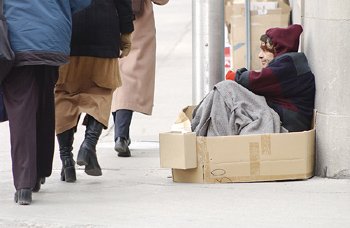As local stakeholders wait for the societal implications of the Gilroy Police Department’s new “no tolerance” stance on “homeless lawlessness” to manifest, the 2013 Santa Clara County “Point-in-Time” census report offers a statistical snapshot of the homeless issue in the city and its environs.
Jan Bernstein-Chargin, chairwoman of Gilroy’s Compassion Center and also the Gilroy Homeless Task Force, hopes the census results will help dispel assumptions about the homeless. The report arrived in the midst of a highly contentious debate about which path Gilroy should take in dealing with its homeless and transient issue, and the timing pleases Bernstein-Chargin.
“I hope that by getting the word out to the public there will be more understanding and less fear,” she noted. “I encourage people to read it and get involved. Volunteer at the Compassion Center. Get to know people.”
Fear of homeless individuals voiced by residents and businesses alike was featured prominently in GPD Chief Denise Turner’s July 1 “Homelessness in Gilroy” report. Delivered by Turner to City Council, the report outlined a new, less forgiving approach to dealing with a core section of habitual criminals within Gilroy’s homeless population. During that meeting, polarizing rhetoric emanated from the dais and members of the community.
Councilman Peter Arellano questioned whether police should be looking for “bad guys” instead of abating homeless encampments. Community member Ruben Ynzunza wanted GPD to focus on homeless troublemakers, or “derelicts” as he referred to them, involved with drinking and illegal drug usage. Councilwoman Terri Aulman voiced the concerns of many in the community who question the logic in expending time, energy and money to help a small group of people who have no interest in being helped.
“Why don’t we get tough and move them on?” she asked, referring to the habitual transient and homeless troublemakers.
That kind of approach, according to Aulman, would free up resources to assist homeless families, the group she is “most concerned” for.
Sorting out who is homeless and who is lawless now rests in the hands of GPD.
Bernstein-Chargin cautions against adopting a one-size-fits-all approach when it comes to figuring out how to move forward in solving a homeless and transient crisis Mayor Don Gage recently called a “catastrophe.”
“It can be dangerous to act on a stereotype,” Bernstein-Chargin warned. “There isn’t a single description (in the census report) of a homeless person.”
The biennial “Point-in-Time” census count conducted by Santa Clara County was one of many conducted across the nation, according to the County. The snapshot of life on the streets was taken on Jan 29 – 30, from daybreak to noon on both days.
That methodology, in Bernstein-Chargin’s opinion, may work better in high-density urban areas compared to the rural expanse of South County.
“It’s better than nothing,” she explained. “But it still leaves a significant undercount.”
Individuals who keep their campsites and cars well-hidden, are on private property, are at work, who sleep in the back room at work, who live in garages, backyards or on a friend’s couch were all missed in the count, reasoned Bernstein-Chargin.
“Many homeless people go to great effort not to look ‘homeless,’” she added, which muddies the water of the data even further as volunteers skip them on sight when counting heads on the streets.
In an attempt to profile their experiences, a questionnaire was administered to 856 unsheltered and sheltered individuals in the weeks that followed. The South Santa Clara County census – which encompasses Gilroy, Morgan Hill, San Martin and other unincorporated areas south of San Jose – depicted some of the most pressing issues facing municipalities, outreach programs, healthcare workers and law enforcement entities.
•South Santa Clara County’s total homeless population is 1,065, down from 1,327 in 2011
•Of the 1,065 individuals, 360 were sheltered – living in emergency shelters or transitional housing – and 705 were unsheltered – defined as living on the street, in a car, in an abandoned building or in an encampment
•Hispanic/Latino individuals make up the majority of South County’s homeless at 54 percent, White/Caucasian make up 25 percent and Black/African-American total 8 percent
•For 45 percent of respondents, it was their first experience with homelessness
•Job loss was the primary reason 43 percent of the people surveyed had ended up homeless
•Ninety-one percent of South County’s homeless are interested in permanent housing, but 61 percent of respondents can’t find a place with affordable rent (countywide, 71 percent of respondents listed their monthly income as $250 or less, a fact Bernstein-Chargin called a “common denominator”)
•When it comes to health problems, 69 percent had one or more disabling conditions. Serious health conditions are dominated by chronic depression (36 percent); post-traumatic stress disorder (31 percent); other mental illness (18 percent); physical disability (16 percent); and substance abuse disorders (14 percent)














